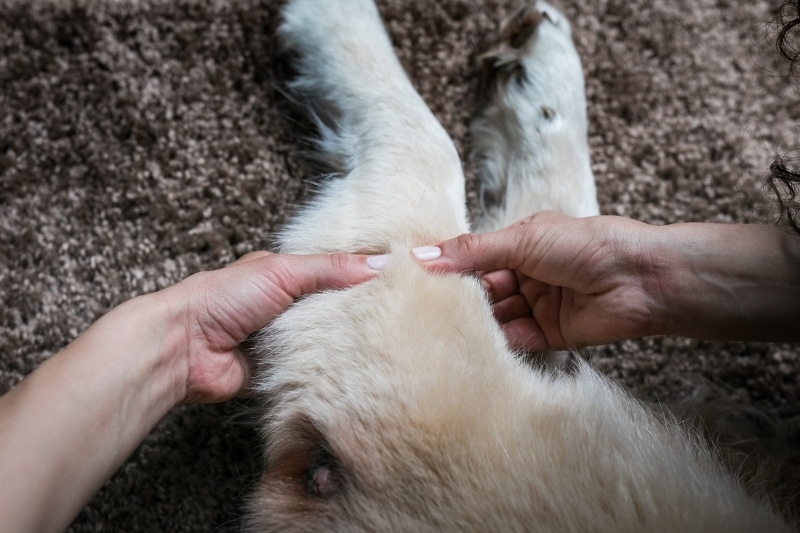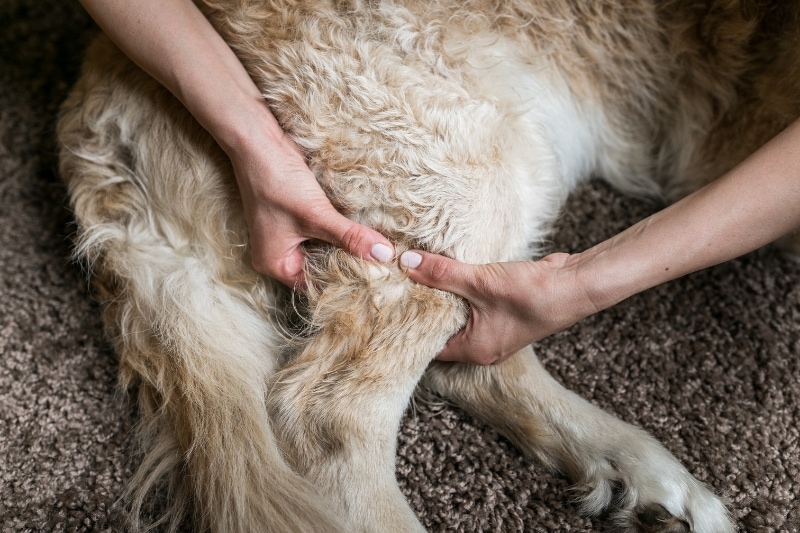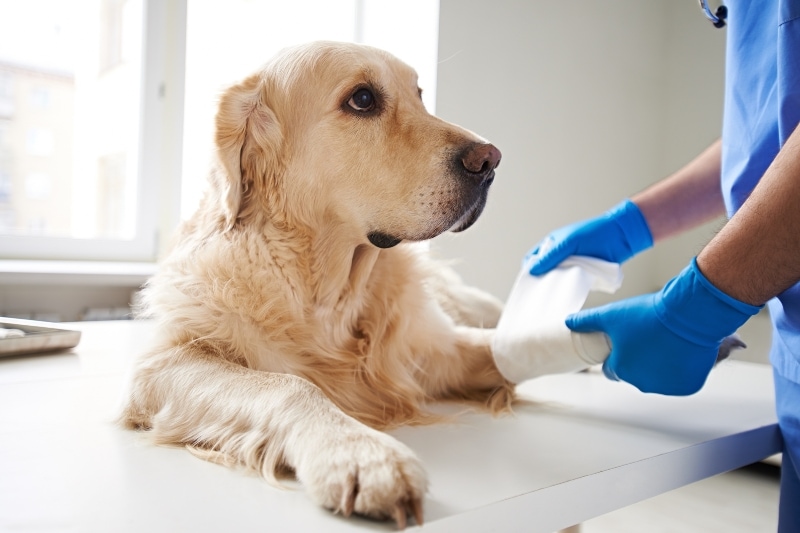
You may be wondering how to promote healing and comfort if your dog has an anterior cruciate ligament (ACL) tear. Giving them a little massage, which helps lessen stress, pain, and inflammation, is one approach to accomplish that.
This post will explain how to massage a dog that has an ACL tear, as well as the potential advantages and safety measures.
You may rely on our expertise as this article is based on the recommendations of licensed veterinarians and professional dog massage therapists. Continue reading to find out how to give your pet a relaxing massage to help them feel better.
Knowing the Symptoms of Your Dog’s Torn ACL
It is imperative for dog parents to monitor their pet’s health. An ACL tear is a common injury in dogs, particularly those who are active. Your dog may experience discomfort and mobility impairments as a result of this injury. But how can you determine whether your dog’s ACL is torn? These are warning indicators to be aware of.

Leaning or Preferring One Hind Leg Only
Imagine being unable to bear weight on one leg when you wake up one day. I assume you would limp. Dogs are just like people, though. Usually, the first indication of an ACL tear is a sudden limp or favoring of one hind limb over the other. It’s essential to pay attention if your dog begins to walk like they just stepped on a Lego.
Symptoms Associated with the Knee Joint
Sometimes, what’s seen is what matters. Physical indicators of an ACL tear may also include redness or edema near the knee joint. Imagine it as the knee of your dog having a tantrum. Dogs with longer fur may not exhibit these symptoms as clearly, but you may still notice your pet biting or licking the region. They express it this way: “This spot? Yes, I find it bothersome.
Decreased Intensity or Hunger
Not only can a torn ACL impair your dog’s movement. It resembles a chain reaction. Additionally, you might observe a decline in their level of activity or hunger. A ruptured ACL can cause discomfort, which could explain why your once-playful dog seems more interested in sleeping than fetching or starts to turn their nose up at their favorite kibble.
Speaking About Pain
Lastly, your dog is sending out a signal for help if they start to scream or whine when they move or touch a leg. Given that dogs are frequently stoic animals, vocalizing discomfort is a severe indicator that your dog is in pain. It’s their way of expressing, “I need help, I’m in pain.”
Massage Therapy’s Advantages for Canines with ACL Tears

Increasing Delivery of Oxygen and Blood Circulation
Your pet may be sidelined by an ACL tear, but a healing touch may make all the difference in the world. Dogs with ruptured ACLs benefit greatly from massage because it improves blood flow and oxygen supply to the afflicted area. This is important because more oxygen and nutrients are delivered to the injured site via increased blood flow, which may hasten the healing process.
Handling Pain and Inflammation
But massage therapy has many more advantages! It has the potential to be an effective method for lowering pain and inflammation. The body’s natural reaction to an ACL tear in a dog is to send fluid to the injured area, which causes inflammation.
Even though this is a typical stage of healing, it may be uncomfortable and prolong the healing process.
Massage can disseminate this fluid by gently manipulating the soft tissues, which can reduce swelling and provide pain relief. It’s similar to giving your dog a safe, all-natural pain reliever. Who wouldn’t want their four-legged companion to have that?
Improving Range of Motion and Joint Mobility
Your dog’s range of motion and mobility may be limited by an ACL tear. By extending the surrounding muscles and gently moving the joint, massage can improve these features. This can help your dog walk around more easily and do daily tasks because it can prevent stiffness and increase flexibility. Recall that a dog who is mobile is healthier!
Encouraging Recuperation and Healing
Finally, by enhancing the body’s inherent healing mechanisms, massage can aid in healing and recuperation. The body naturally produces endorphins, which are painkillers, and less cortisol, which is a stress hormone, when you get a massage. This may produce a setting that is more healing-friendly. Furthermore, a contented dog is more likely to sleep, which is essential for healing.
A Comprehensive Guide on How to Massage a Dog with a Torn ACL

Getting Everything Ready for a Calm Massage
Establish a calm, cozy space before you begin so your dog feels secure and at ease. If it’s quiet and uncluttered, it could be your living room, bedroom, or even your backyard.
A soft towel or blanket, as well as some of your dog’s favorite toys and treats, should be kept close by. To begin, give your dog a gentle brushing to get rid of any dirt or hair matting in their coat. They will also get more at ease and prepared for the massage by doing this.
Getting Your Dog Warmed Up
Like human athletes, dogs gain from warming up before a competition. To calm your dog and get him ready for the massage, start by caressing him in his favorite locations.
Slowly and gently stroke your dog’s torso, head, and ears using flat palms and minimal pressure. Keep an eye out for any places that feel uncomfortable and steer clear of them. To enhance blood circulation and oxygen supply to the muscles and joints of your dog, apply the thumb-circle technique to the neck, shoulders, and chest.

Providing Affected Leg with Massage
It’s time to concentrate on the afflicted limb now. With one hand under the knee and the other under the paw, carefully raise the leg and support it. Massage your dog’s thigh’s large muscles in the front (quadriceps) and rear (hamstrings) with firm, steady pressure.
Beginning at the knee and working your way slowly up the leg, begin massaging. Employ a mix of compression, friction, petrissage, and effleurage strokes.
Recall that a massage ought to take a maximum of several minutes. If your veterinarian instructs you otherwise, don’t massage your dog’s leg for longer than three to five minutes.
Calming Down Your Dog
We will conclude with a cool-down, just as we began with a warm-up. Gently touch your dog’s body, head, and ears using the same flat palms and moderate pressure as the warm-up massage.
Give your dog a treat as a reward and watch for any bleeding, redness, or swelling in the injured leg. Make quick contact with your veterinarian if you observe any of these.
Recall that the purpose of this massage is to aid in your dog’s healing and pain relief. It doesn’t take the place of qualified veterinary care. Prior to beginning your dog’s new therapy or treatment, always check with your veterinarian.
How to Massage a Dog With Torn ACL: Risks Involved

Your natural reaction is to lend a hand to a member of your family who has a torn ACL and is in pain. A soothing method to reduce their agony and promote recovery may be massage treatment.
But there are hazards associated with every treatment. Inadequate application of massage therapy may unintentionally exacerbate the injury. Let’s examine the possible hazards and strategies for avoiding them.
- Picture this: You’re attempting to alleviate your dog’s pain by massaging the injured area, but your well-meaning efforts unintentionally escalate the injury. This is a real risk when dealing with a torn ACL, and it’s crucial to be aware of it.
- Moreover, there’s a risk of introducing infection or bacteria to the wound if it’s not thoroughly cleaned before the massage. This could lead to complications that could potentially prolong your dog’s recovery period.
- Lastly, some dogs may respond negatively or aggressively to massage, especially if they’re in pain. This is a risk to both you and your dog, as it could lead to stress, fear, and even bites or scratches.
Concluding
In conclusion, even though massage treatment can help a dog who has an ACL tear, it’s crucial to understand the hazards and take the appropriate safety measures.
To assist your dog recover from an ACL tear, keep in mind that early detection and treatment are essential. Thus, be alert for these indicators and don’t be afraid to contact your veterinarian if you think your dog might be hurt.
An X-ray or ultrasound, along with a physical examination, can help your veterinarian detect an ACL tear. After that, they can advise on the most appropriate course of action, which might involve surgery, medicine, physical therapy, or simply rest.